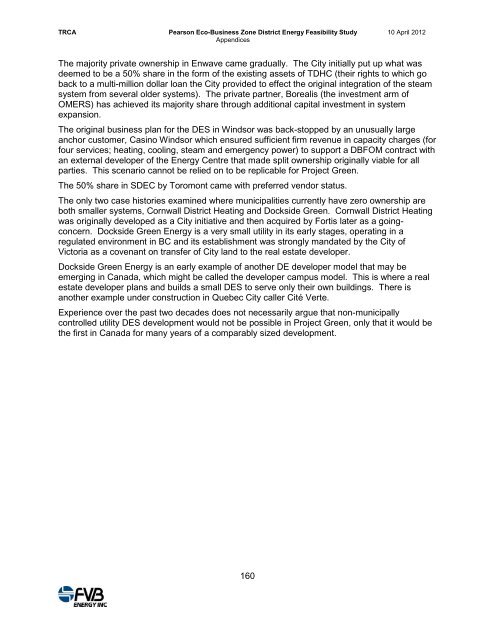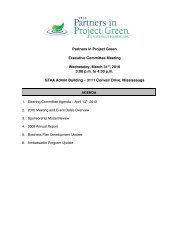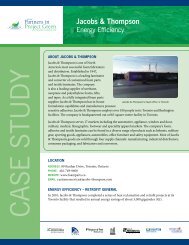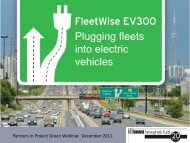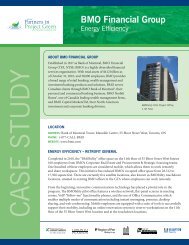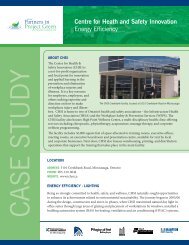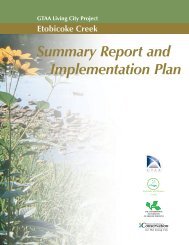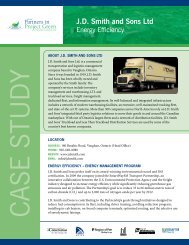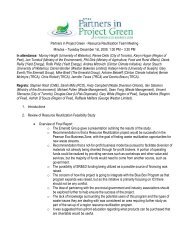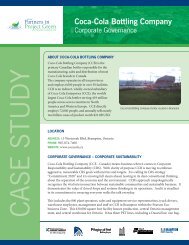Project Green District Energy Feasibility Study - Partners in Project ...
Project Green District Energy Feasibility Study - Partners in Project ...
Project Green District Energy Feasibility Study - Partners in Project ...
You also want an ePaper? Increase the reach of your titles
YUMPU automatically turns print PDFs into web optimized ePapers that Google loves.
TRCA Pearson Eco-Bus<strong>in</strong>ess Zone <strong>District</strong> <strong>Energy</strong> <strong>Feasibility</strong> <strong>Study</strong> 10 April 2012<br />
Appendices<br />
The majority private ownership <strong>in</strong> Enwave came gradually. The City <strong>in</strong>itially put up what was<br />
deemed to be a 50% share <strong>in</strong> the form of the exist<strong>in</strong>g assets of TDHC (their rights to which go<br />
back to a multi-million dollar loan the City provided to effect the orig<strong>in</strong>al <strong>in</strong>tegration of the steam<br />
system from several older systems). The private partner, Borealis (the <strong>in</strong>vestment arm of<br />
OMERS) has achieved its majority share through additional capital <strong>in</strong>vestment <strong>in</strong> system<br />
expansion.<br />
The orig<strong>in</strong>al bus<strong>in</strong>ess plan for the DES <strong>in</strong> W<strong>in</strong>dsor was back-stopped by an unusually large<br />
anchor customer, Cas<strong>in</strong>o W<strong>in</strong>dsor which ensured sufficient firm revenue <strong>in</strong> capacity charges (for<br />
four services; heat<strong>in</strong>g, cool<strong>in</strong>g, steam and emergency power) to support a DBFOM contract with<br />
an external developer of the <strong>Energy</strong> Centre that made split ownership orig<strong>in</strong>ally viable for all<br />
parties. This scenario cannot be relied on to be replicable for <strong>Project</strong> <strong>Green</strong>.<br />
The 50% share <strong>in</strong> SDEC by Toromont came with preferred vendor status.<br />
The only two case histories exam<strong>in</strong>ed where municipalities currently have zero ownership are<br />
both smaller systems, Cornwall <strong>District</strong> Heat<strong>in</strong>g and Dockside <strong>Green</strong>. Cornwall <strong>District</strong> Heat<strong>in</strong>g<br />
was orig<strong>in</strong>ally developed as a City <strong>in</strong>itiative and then acquired by Fortis later as a go<strong>in</strong>gconcern.<br />
Dockside <strong>Green</strong> <strong>Energy</strong> is a very small utility <strong>in</strong> its early stages, operat<strong>in</strong>g <strong>in</strong> a<br />
regulated environment <strong>in</strong> BC and its establishment was strongly mandated by the City of<br />
Victoria as a covenant on transfer of City land to the real estate developer.<br />
Dockside <strong>Green</strong> <strong>Energy</strong> is an early example of another DE developer model that may be<br />
emerg<strong>in</strong>g <strong>in</strong> Canada, which might be called the developer campus model. This is where a real<br />
estate developer plans and builds a small DES to serve only their own build<strong>in</strong>gs. There is<br />
another example under construction <strong>in</strong> Quebec City caller Cité Verte.<br />
Experience over the past two decades does not necessarily argue that non-municipally<br />
controlled utility DES development would not be possible <strong>in</strong> <strong>Project</strong> <strong>Green</strong>, only that it would be<br />
the first <strong>in</strong> Canada for many years of a comparably sized development.<br />
160


